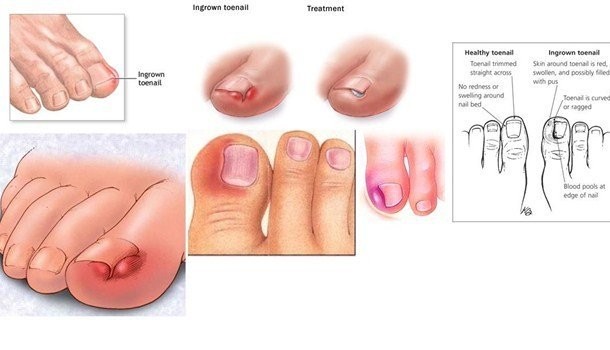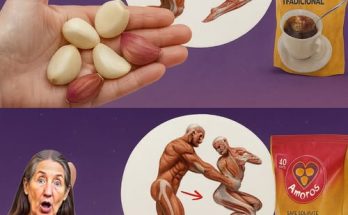
Ingrown Toenails
Ingrown toenail is a condition known to physicians as onychocryptosis. Ingrown toenails are common, painful conditions that occur when the skin on the side of a toenail grows over the edge of the nail, or when the nail grows into the skin. An ingrown toenail is one of the most common foot afflictions, not to mention one of the most painful. The problem usually occurs on the big toe, with the sides or upper corners of the nail curling down and cutting into soft tissue, causing swelling and redness. Besides being painful, ingrown toenails can also lead to infection.
Causes of Ingrown Toenails
Ingrown toenails can develop for many reasons. In some cases, the toenails are simply too large or the condition develops as a result of genetically inherited tendencies. Persons whose toes curl (congenitally or from disease such as arthritis) are prone to onychocryptosis. Trauma, such as stubbing a toe or having one stepped on can cause a piece of the nail to jam into the skin. Frequent running also can cause ingrown toenails.
Ingrown nails can be caused by trimming them incorrectly, causing them to regrow into the skin, by excessively tight stockings, or by shoes with narrow toe boxes. Bedridden patients commonly develop ingrown toenails if the bedsheets are kept tucked-in tightly.
Fungal infections can also cause ingrown toenails. In some cases, the infection progresses toward and beneath the cuticle into the root of the nail, causing damage that results in an abnormal growth pattern.
Ingrown Toenail Signs and Symptoms
Onychocryptosis should be treated as soon as it develops. If the skin is red, painful, or swollen on the sides of the nail, there may be an infection. The ingrown nail is in warm, often moist, and bacteria-rich environment and it provides a convenient entry for germs that can cause infection. At first, the skin around the nail may be mildly red or inflamed.
Untreated, the nail can go under the skin, causing a severe infection. The infection must be cured using sterile instruments and antibiotics. People who attempt to fix an infected toenail themselves may worsen the problem.
Treatment for Ingrown Toenails
Uninfected ingrown toenails can be treated following this regimen:
- soak the feet in warm soapy or salt water;
- dry them thoroughly with a clean towel;
- apply a mild antiseptic solution to the area; and
- bandage the toe.
Various over-the-counter preparations are available that can harden the skin and shrink the soft tissue along the edge of the nail so it grows normally. A soft, foam toecap can be worn while the ingrown nail heals.
If excessive inflammation, swelling, pain, and discharge develops, the toenail probably is infected and should be treated by a physician. A podiatrist can trim or remove the infected nail with a minor in-office surgical procedure. A portion of the nail or overgrown skin is removed with a scalpel and the infection is treated.
If an ingrown toenail recurs, it may require a more permanent solution. A small portion of the nail and nail matrix (part of the nail that actually grows) is removed with a scalpel or cauterized with a concentrated chemical solution. This makes the nail narrower and prevents a portion of the nail from growing back, ensuring that it will not irritate the adjacent skin.
The chemical treatment is a slightly less invasive procedure. It causes mild inflammation that lasts about a week. This procedure often cannot be used in severe infections because the chemical used (phenol) may be neutralized by the infection. In these cases, the physician must remove the infected nail first, and treat the infection.
Ingrown Toenail Prevention
Unless the problem is congenital, the best way to prevent ingrown toenails is to protect the feet from trauma and wear shoes with adequate room for the toes. Nails should be trimmed straight across with clippers to a comfortable length.
- Trim your nails carefully. When trimming toenails, follow these directions to keep them from becoming ingrown:
- Cut the nail neatly. Use heavy long-handled scissors or a nail clipper.
- Don’t tear. Always trim the nail; never tear it away with your fingers.
- Always trim the nail straight across. The end of the nail should be square, not a half moon. Don’t trim too close. Finish the edge with an emery board or nail file and clean the grooves with an orange stick.
- Keep your feet clean and dry. Daily attention to hygiene may help head off infection.
- Wear comfortable shoes. Shoes should be comfortable when you buy them. They should not rub, pinch, or bind the front of your feet in the area known as the toe box. Avoid high heels or tight-fitting shoes; these place abnormal pressure on your toes.
- Protect your feet. If you expect to be lifting heavy objects, be sure to wear sturdy shoes to protect your feet.
Home Remedies for Ingrown Toenail
- Investigate the source. If you have developed an ingrown toenail, try to determine the cause and then eliminate it.
- Soak and pack. Soak your toe in warm water for 15 to 25 minutes to soften the nail and drain out any inflamed material under the nail. If the nail is not extremely painful or infected, gently massage over the skin then use clean cotton (wet) or antiseptic and tweezers to raise the nail and press a few strands of absorbent cotton or a piece of dental floss under the nail to keep it from further cutting the skin. Repeat this process daily, until the nail finally grows out past the nail fold.
- Take pain relievers. Take acetaminophen or nonprescription NSAIDs—aspirin, ibuprofen, or naproxen—as needed.
- Don’t cut in the middle. Contrary to myth, making a V-shaped cut in the middle of your toenail won’t make it grow toward the middle and thus won’t prevent an ingrown toenail.
- Consider changing your shoes. If possible, switch to open shoes, shoes with a wider toe box, or sneakers while your nail is healing.
- Be careful when you’re on your feet. Avoid running or other strenuous activities involving your feet while your toe heals.




